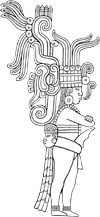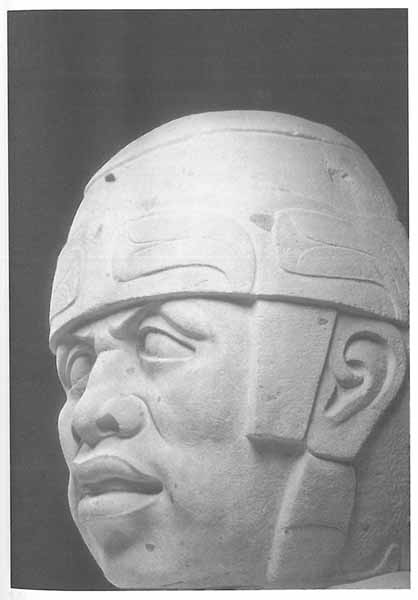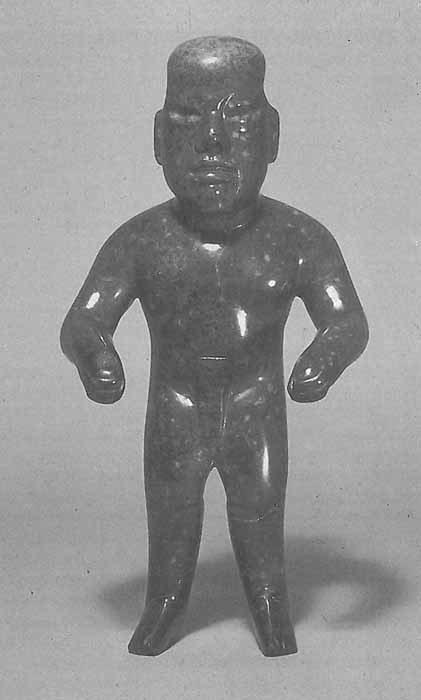

|
Death Gods, Smiling Faces and Colossal Heads: Archaeology of the Mexican Gulf Lowlands by Richard Diehl |
|
| |
The Rise of Complex Societies - Early and Middle Formative Periods The civilizations which flourished in the Gulf Coast lowlands after 1200 B.C. have fascinated archaeologists for almost a century. However, most of the investigations have focused on architecture, sculpture, ritual objects of stone and clay and other remnants of elite culture while neglecting many equally important but less spectacular topics. Although this one-sided approach has begun to change in recent decades, what we know about public architecture, sculpture, and art far exceeds what we know about subsistence, trade, and the ordinary utilitarian implements that made life possible. Thus, we can write a reasonably accurate chronicle of the history of cultures as mirrored in the spectacular remains of the elite but, with few exceptions, cannot explain what happened or why. Civilizations are special kinds of human societies that have appeared only infrequently in the human past. They are more complex than the smaller-scale, simpler societies that preceded them. Their defining characteristics include complex social hierarchies, economic structures, and political systems; clearly defined territories or spheres of influence; "capitals" that are larger than the satellite communities subordinate to them and that, in some cases, are true cities or urban centers; and high attainments in the arts. Architecture, calendrics, religion, ritual, written and oral literature, and other branches of esoteric knowledge reflect the presence of an upper class or elite, perhaps the trait that most distinguishes civilizations from their less complex and organized predecessors. The Formative Olmecs of southern Veracruz and western Tabasco were the earliest civilization in our region and perhaps in the entire Americas. Their name is a modern corruption of Olmecatl (Nahuatl "Rubber People" or "People of the Rubber Country"), by which the Aztecs referred to the inhabitants of the region during the Late Postclassic period. G. Lowe (1989:36) has divided Formative Period Olmec culture into five phases: Pre-Olmec (1500-1200 B.C.), Initial Olmec (1200-900 B.C.), Intermediate Olmec (900-600 B.C.), Late Olmec (600-300 B.C.), and Epi-Olmec (300 B.C.-1 A.D.).; Although recent investigations at la Venta and elsewhere suggest that this developmental scheme may require substantial revision in the future, it is useful for our present purposes. Pre-Olmec cultures similar to the Barí-phase remains already described lack any indications of social complexity or the other characteristics of civilization. The Initial and Intermediate Olmec phases date to the Early and Middle Formative periods; Initial Olmec coincides with San Lorenzo's growth and development, its emergence as an important cultural power in southern Mesoamerica, and its ultimate decline at the beginning of the first millennium B.C. La Venta replaced San Lorenzo during the Intermediate Olmec phase and climaxed in subsequent Terminal Olmec times. Tres Zapotes and other sites located northwest of the Tuxtla Mountains came into power in Epi-Olmec times while under the strong stylistic influence of societies on the Pacific coastal region of Chiapas and Guatemala. Olmec commoners lived in small villages indistinguishable from those of earlier times, but the newly emergent elites along with their dependents and retainers occupied larger settlements that we can justifiably call towns. These communities became the foci of economic power, political influence, and religious leadership. Many such towns probably existed, but only San Lorenzo, la Venta, Laguna de los Cerros, and Tres Zapotes have been studied by archaeologists. Not only were these towns larger than the subordinate villages surrounding them, they also contained stone sculptures; temples and elite houses placed on the summits of earth mounds; and buried caches and offerings containing discarded monuments, greenstone celts, and figurines as well as other rare and highly prized objects. Magnificently carved stone sculptures are the hallmark of Olmec culture. Stones quarried in the Tuxtla Mountains, some weighing many tons, were transported over distances of more than 150 kilometers by water and land. The corpus of sculptures includes colossal human heads that may be portraits of rulers (Fig. 4.1); huge flat-topped "altars" or thrones; realistically depicted life-size human figures; and a bewildering assortment of human, animal, and intermediate forms that combine traits of both. Scores of monuments must have been displayed simultaneously at every large Olmec center, but since few if any have been found in their original placement, it is impossible to know how they were arranged. It does seem likely that each monument formed an element in the visual expression of some now lost myth or epic tale concerned with the lives of the rulers or their ancestors.
A unique Olmec style is evident in both the monumental sculptures and the smaller portable objects of jadeite, serpentine, clay, and other materials (Fig. 4.2). According to one authority, "the Olmec style is strongly contrasted with all other Middle American styles not only in its iconographic content of baby-faced, snarling were-jaguars and cleft heads but in its formal qualities of shape, line, and space. In the sense that it eschews geometric abstraction for curvilinear naturalism, the style is "realistic"; in fact, it is more 'realistic' than even the Classic Maya, if one takes into account that the Olmec artists were depicting creatures that they believed actually existed, no matter how monstrous or far-fetched" (M. D. Coe I965b: 747-48). So distinctive is this style and its components that pieces that display it can be readily attributed to Olmec artisans regardless of where the object was discovered in modern times.
The hearth of the Olmec style has been debated vigorously for decades. Most authorities believe that it grew out of an earlier artistic complex indigenous to the Olmec heartland but executed in wood, cloth, and other media that have failed to survive the ravages of time. Not everyone agrees, however, and some scholars still seek its antecedents in Guerrero, Oaxaca, Chiapas, or other regions of southern Mesoamerica. Recent investigations at El Manati, a small Olmec site in the Coatzacoalcos river basin, have revealed well-preserved wooden sculptures and objects of rubber and other perishable materials immersed in a permanently wet spring (Ortiz and Rodriguez 1989). The first objects were exposed by the local inhabitants in 1988, since then Ponciano Ortiz C. and his colleagues have conducted careful excavations during numerous field seasons. The total inventory of objects recovered include forty-plus wooden busts, ten wooden scepters, nine rubber balls, and more than one hundred greenstone celts, including one beautifully polished example with a child- or dwarf-size footprint carved into the surface. The busts are worked from an easily carved soft wood and feature faces stylistically identical to Olmec carvings in stone. Most of the wooden scepters are shaped like serpents, and one has a shark's tooth mounted on the end. They may have signified royal power in a manner analogous to the Manikin Scepter of later Classic period Maya culture. The rubber balls probably were used in ballgame rituals carried out on "Palangana"-style ballcourts enclosed by four earth mounds similar to that excavated at nearby San Lorenzo. The remarkable preservation of this treasure trove owes to their objects' deliberate placement in the bottom of the spring, perhaps as offerings to a water deity at sometime after 1000 B.C. Someday even older wooden objects may appear in the Olmec region, providing the long-sought-for answers to questions about the origins and antiquity of the Olmec art style, the root stock from which all later Mesoamerican styles grew. Olmec society contained at least two social strata: a small ruling elite and a much larger group of commoners. Monuments depict rulers wearing sumptuous capes, headdresses, jewelry, and other articles of clothing symbolic of their high status. The elite mobilized large work parties, perhaps numbering in the thousands, to construct earthen mounds, transport basalt from quarries in the Tuxtlas, and carry out other projects requiring the efforts of entire communities. They also controlled long-distance trade and exchange systems that supplied them and their supporters with obsidian, serpentine, jadeite, pottery, feathers, iron ore ornaments, and other raw materials and luxury goods that enhanced their prestige. These goods and materials came from central Mexico, Morelos, Guerrero, Oaxaca, coastal Chiapas, and Guatemala and probably were paid for with cacao, jaguar pelts, crocodilian skins, stingray spines, and an array of finished products in the Olmec style. While most scholars agree that the Olmecs "influenced" their neighbors and later Mesoamerican civilizations, the nature and extent of their impact is the subject of spirited debate (cf. essays in Sharer and Grove 1989). Some maintain that the Olmecs were Mesoamerica's mother culture, the precocious base civilization that set the example for its less highly developed neighbors. Others maintain that Olmec societies were no more complex than their contemporaries' elsewhere in Mesoamerica and that the widespread occurrence of Olmec motifs and stylistic conventions result from preexisting ideas and practices in many areas, rather than diffusion from a single Olmec source. Similarly, some authorities stress the continuities, especially in art, ideology, and religion, between Olmec culture and later civilizations; while others emphasize the differences that appeared during the later evolution of urban life. |
|
|
Text links to all pages at this site are available at the FAMSI INDEX |
||

